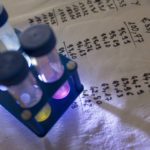Link to Pubmed [PMID] – 32797039
Link to DOI – 10.1371/journal.pbio.3000814
PLoS Biol 2020 08; 18(8): e3000814
Plasmid-mediated horizontal gene transfer of antibiotic resistance and virulence in pathogenic bacteria underlies a major public health issue. Understanding how, in the absence of antibiotic-mediated selection, plasmid-bearing cells avoid being outnumbered by plasmid-free cells is key to developing counterstrategies. Here, we quantified the induction of the plasmidial sex pheromone pathway of Enterococcus faecalis to show that the integration of the stimulatory (mate-sensing) and inhibitory (self-sensing) signaling modules from the pCF10 conjugative plasmid provides a precise measure of the recipient-to-donor ratio, agnostic to variations in population size. Such ratiometric control of conjugation favors vertical plasmid transfer under low mating likelihood and allows activation of conjugation functions only under high mating likelihood. We further show that this strategy constitutes a cost-effective investment into mating effort because overstimulation produces unproductive self-aggregation and growth rate reduction. A mathematical model suggests that ratiometric control of conjugation increases plasmid fitness and predicts a robust long-term, stable coexistence of donors and recipients. Our results demonstrate how population-level parameters can control transfer of antibiotic resistance in bacteria, opening the door for biotic control strategies.

